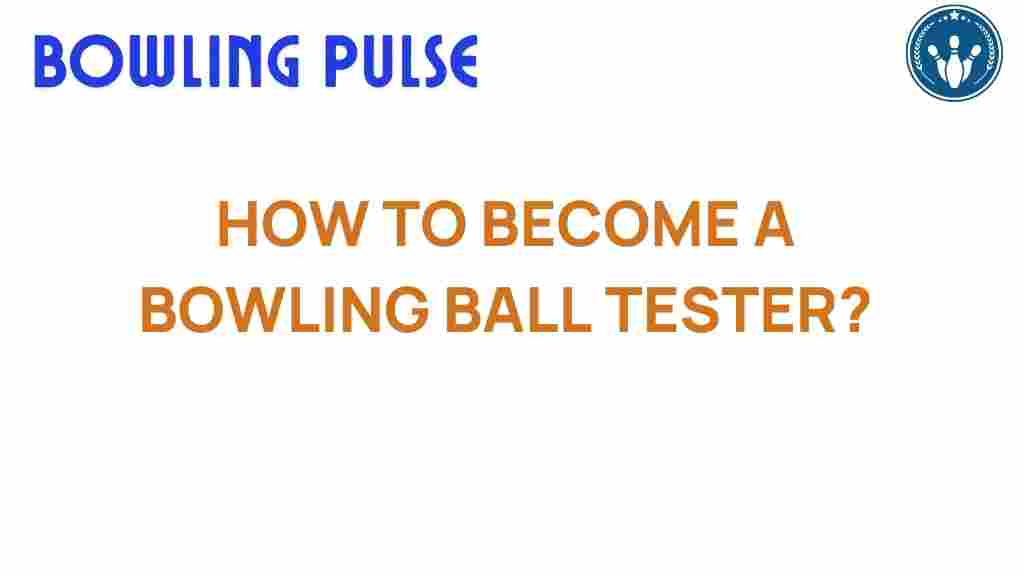Unlocking the Secrets: How to Become a Bowling Ball Tester
Have you ever wondered how the bowling industry ensures that every bowling ball meets high-performance standards? The role of a bowling ball tester is vital in maintaining the quality and technology of these essential pieces of equipment. If you are passionate about sports careers and want to contribute to bowling performance, then becoming a bowling ball tester might be the perfect path for you. In this article, we will explore the world of bowling ball testing, the skills you need, how to get started, and insider tips to excel in this unique career.
The Importance of Bowling Ball Testing in the Bowling Industry
The bowling industry is continuously evolving, with advancements in bowling technology and equipment testing. Bowling balls are engineered with specific materials and designs to enhance performance on the lanes. A bowling ball tester evaluates these products to ensure they meet safety and performance standards. Testing helps in:
- Ensuring consistency in performance
- Identifying manufacturing defects
- Improving player experience and satisfaction
- Staying competitive in the market
As a bowling ball tester, you play a crucial role in this process, impacting both amateur and professional bowlers alike.
Skills Required to Become a Bowling Ball Tester
To thrive as a bowling ball tester, you need a combination of technical skills and personal attributes. Here are some essential skills:
- Attention to Detail: You must be able to identify subtle differences in ball performance.
- Analytical Skills: Understanding the impact of various materials and designs on performance is essential.
- Communication Skills: You will need to provide feedback to manufacturers and collaborate with other testers.
- Knowledge of Bowling: A deep understanding of bowling techniques and player preferences is crucial.
- Technical Proficiency: Familiarity with equipment testing methods and technologies.
Step-by-Step Process to Become a Bowling Ball Tester
Becoming a bowling ball tester involves several steps. Here’s a comprehensive guide to help you get started:
Step 1: Education and Background
While there is no formal educational requirement, a background in sports science, engineering, or materials science can be beneficial. Courses in physics, mechanics, or even business can provide valuable insights into the bowling industry.
Step 2: Gain Relevant Experience
Experience in the bowling industry is crucial. You can gain experience by:
- Working in a bowling alley: Learn about different types of bowling balls and how they perform.
- Participating in bowling leagues: Understand the needs and preferences of bowlers.
- Interning with bowling manufacturers: Gain hands-on experience in equipment testing.
Step 3: Networking in the Bowling Industry
Networking is key to advancing your career. Attend bowling tournaments, trade shows, and industry events. Join online forums and social media groups related to bowling. Building relationships with professionals in the field can open doors to opportunities.
Step 4: Apply for Testing Positions
Once you have the necessary education and experience, start applying for bowling ball tester positions. Look for job openings at bowling ball manufacturers, testing facilities, and sports organizations. Tailor your resume to highlight your relevant skills and experiences.
Step 5: Continuous Learning and Development
The bowling industry is always changing, with new technologies and materials emerging. Stay updated on the latest trends in bowling technology and equipment testing. Consider attending workshops, certifications, and training programs to improve your skills.
Troubleshooting Tips for Bowling Ball Testing
As a bowling ball tester, you may encounter various challenges during the testing process. Here are some troubleshooting tips:
- Inconsistent Performance: If a ball shows inconsistent performance, check for surface irregularities or damage. Ensure that the testing conditions are the same for all balls.
- Material Issues: If you notice problems with the ball’s material, consult with the manufacturer about potential defects or quality control issues.
- Feedback Miscommunication: Always document your findings clearly and communicate with manufacturers to ensure they understand your feedback.
Insider Tips for Aspiring Bowling Ball Testers
Here are some insider tips to help you succeed as a bowling ball tester:
- Be Passionate: Your love for the sport will shine through in your work.
- Stay Objective: Always base your evaluations on facts and data rather than personal preferences.
- Embrace Technology: Familiarize yourself with the latest testing technologies and methods.
- Collaborate: Work closely with engineers and designers to understand their perspectives and improve your testing processes.
The Future of Bowling Ball Testing
The future of the bowling industry is bright, with advancements in materials and technology leading to better bowling balls. As a bowling ball tester, you will play a significant role in shaping these innovations. Understanding consumer demands and technological advancements will be crucial as the industry evolves.
Moreover, the integration of data analytics and AI into the testing process is on the rise. Testers who can leverage these technologies will have a competitive edge in ensuring quality assurance and enhancing bowling performance.
Conclusion
Becoming a bowling ball tester is an exciting journey that combines your passion for the sport with technical expertise. By following the outlined steps, gaining experience, and continuously learning, you can carve out a niche for yourself in the bowling industry. Whether you are testing new products, providing feedback to manufacturers, or helping bowlers find the perfect ball, your role will significantly impact the sport. Start your path today, and unlock the secrets of becoming a successful bowling ball tester!
For more information on sports careers and equipment testing, check out this resource. If you’re looking to dive deeper into bowling technology, visit this link for the latest insights.
This article is in the category Equipment and created by BowlingPulse Team
